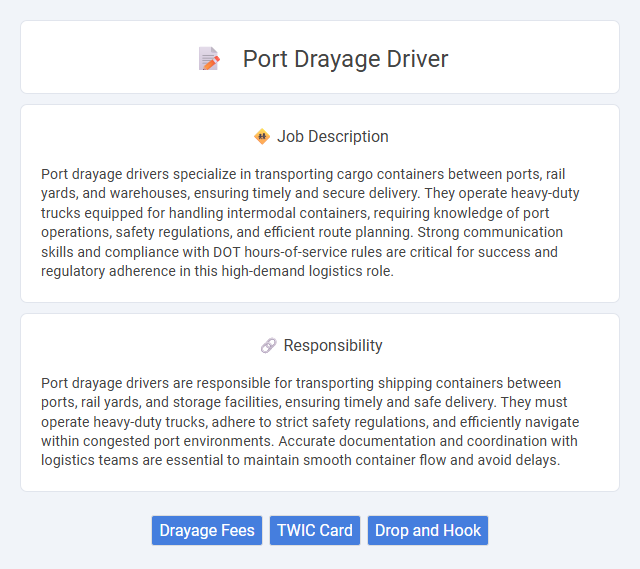
Port drayage drivers specialize in transporting cargo containers between ports, rail yards, and warehouses, ensuring timely and secure delivery. They operate heavy-duty trucks equipped for handling intermodal containers, requiring knowledge of port operations, safety regulations, and efficient route planning. Strong communication skills and compliance with DOT hours-of-service rules are critical for success and regulatory adherence in this high-demand logistics role.
Port drayage drivers likely need strong physical endurance and stress management skills due to long hours and demanding working conditions. Individuals who thrive in fast-paced, independent environments with a high tolerance for variability may be better suited for this role. Those with limited patience for traffic congestion, tight schedules, or heavy labor might find this job challenging.
Qualification
Port drayage drivers must possess a valid commercial driver's license (CDL) with the appropriate endorsements, such as hazardous materials (HazMat) or double/triple trailers. Proven experience operating heavy-duty trucks in port or industrial environments is essential to handle tight schedules and complex logistics. Strong knowledge of safety regulations, vehicle maintenance, and efficient route planning are critical qualifications for this role.
Responsibility
Port drayage drivers are responsible for transporting shipping containers between ports, rail yards, and storage facilities, ensuring timely and safe delivery. They must operate heavy-duty trucks, adhere to strict safety regulations, and efficiently navigate within congested port environments. Accurate documentation and coordination with logistics teams are essential to maintain smooth container flow and avoid delays.
Benefit
Port drayage driver jobs likely offer competitive pay due to the high demand for efficient transportation of containers between ports and nearby facilities. These positions may provide benefits such as flexible scheduling, access to safety training, and potential for overtime earnings. Drivers could also receive health insurance packages, retirement plans, and opportunities for career advancement within logistics companies.
Challenge
Port drayage driver jobs likely involve navigating busy port terminals and adhering to strict delivery schedules, making time management a significant challenge. Drivers probably face congestion and complex routing that can increase stress and require strong problem-solving skills. Safety concerns and regulatory compliance are also common obstacles that may demand constant vigilance on the part of drivers.
Career Advancement
Port drayage drivers play a critical role in transporting containers between ports and distribution centers, offering steady demand in the logistics sector. Career advancement opportunities include roles such as fleet supervisor, logistics coordinator, or machinery operator, often supported by certifications in logistics management and advanced driving endorsements. Mastery of port operating procedures and safety regulations can accelerate progression into higher-paying management positions within transportation companies.
Key Terms
Drayage Fees
Drayage fees for port drayage drivers vary based on distance, cargo type, and container size, typically ranging from $150 to $400 per trip. These fees cover costs such as fuel, labor, equipment usage, and port access charges. Efficient management of drayage fees is critical for optimizing supply chain costs and ensuring competitive freight rates.
TWIC Card
Port drayage drivers are required to possess a valid Transportation Worker Identification Credential (TWIC) card to access secure maritime facilities and terminals. The TWIC card enhances security by verifying the identity and background of individuals involved in port operations, streamlining entry for authorized personnel. Holding a TWIC card is mandatory for drayage truck drivers transporting cargo containers to and from ports, ensuring compliance with federal security regulations.
Drop and Hook
Port drayage drivers specializing in drop and hook operations enhance efficiency by transporting containers to and from ports using pre-loaded trailers, minimizing dwell time and maximizing load cycles. This method reduces wait times at terminals, enabling quicker turnaround for freight movement in supply chain logistics. Expertise in handling chassis, adhering to port regulations, and coordinating with yard operators is essential for optimizing container drayage services.
 kuljobs.com
kuljobs.com